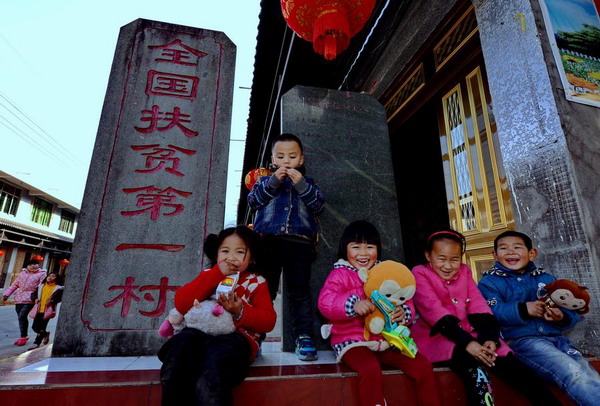A new concept and drive to reduce poverty
China Daily by Wu Guobao, March 15, 2016 Adjust font size:
|
Children of Se ethnic group sit in front of a monument that reads "China's No. 1 Poverty Relief Village" at Chixi Village, Panxi town, Fuding city in East China’s Fujian province, Feb 14. The village has shaken off poverty thanks to assistance from Party and government officials at all levels over the past 30 years. [Photo/Xinhua] |
Targeted poverty relief is very important for China to meet the poverty alleviation target set out in the Rural Poverty Relief and Development Outline (2011-20). To achieve that goal, we have to change our concepts of poverty relief and development, reform management system and poverty alleviation. That is also important to improve the working mechanism of targeted poverty relief.
First, some local authorities misunderstand the meaning of targeted poverty relief. They assume the policy is aimed at helping the targeted group increase its income in the short term, or directly allocating poverty alleviation funds to the impoverished group.
In fact, targeted poverty relief means comprehensive, scientific, high-quality, highly efficient and continuous poverty alleviation. The poverty relief targets stated in the outline have to be achieved in an all-round way-the authorities have to plan and implement poverty relief measures according to the principle of poverty alleviation, implement high-quality poverty relief development projects and intervention measures, as well as improve the lot of the targeted impoverished group.
Second, poverty relief management systems and policies that are not suited to meet the demands of targeted poverty relief should be changed. Establishing a set of precise poverty relief management systems and policies that are very efficient, coordinated, and guarantee equal rights and responsibilities is essential for achieving poverty relief targets. The authorities have to strictly implement the management systems of poverty alleviation: central authorities should devise the overall plans, and provincial authorities should take the full responsibility of implementing them with local authorities helping them meet the poverty alleviation targets.
Top leaders of local Party committees and local governments are in charge of poverty alleviation and development work. Pilot projects should be introduced in key impoverished counties to reduce special transfer payments and increase general transfer payments. Plus, local authorities should be granted more power in policymaking, implementation and management of poverty relief.
Third, the authorities have to deal with the complications that emerge during the implementation of targeted poverty relief programs. Steadily increasing low-income families' earnings is the key, but difficult-to-achieve, factor in poverty alleviation work.
